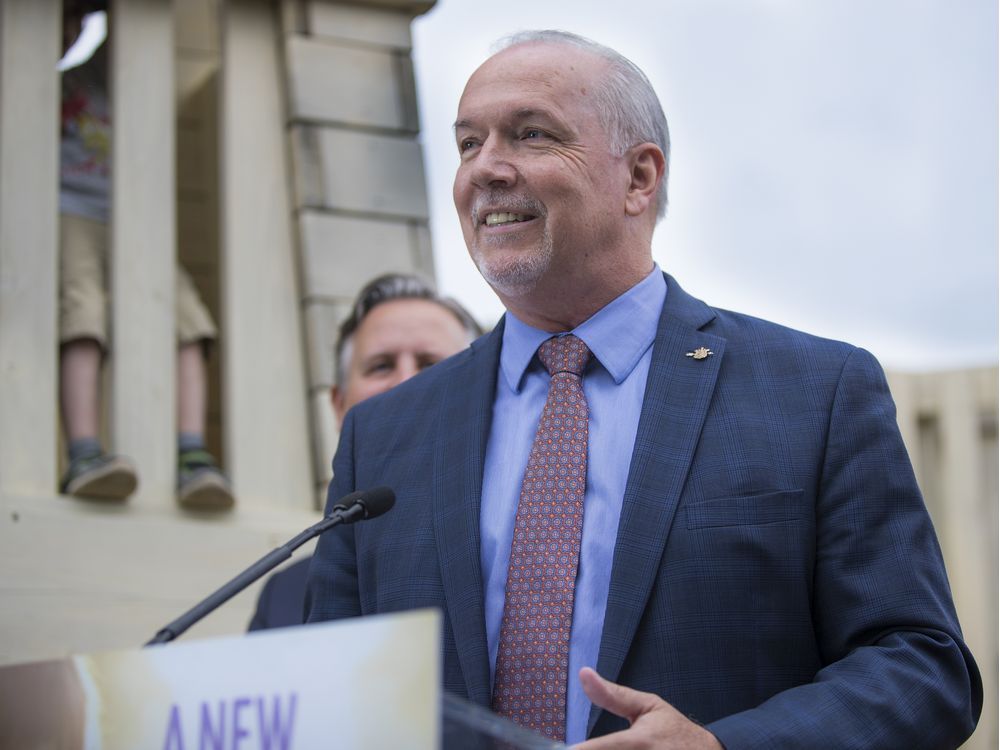Vaughn Palmer: Horgan misspoke of B.C. being woke about Pro Rep, and other things

Credit to Author: Stephen Snelgrove| Date: Sat, 14 Dec 2019 02:25:53 +0000
VICTORIA — Throughout last year’s referendum on electoral reform, there was a common assumption that younger voters would deliver a strong vote in favour of proportional representation.
The opinion polls suggested they were more likely to support change. Traffic on social media reinforced the impression. Pro Rep-favouring politicians treated the notion as a given.
During the televised leader’s debate, Premier John Horgan deliberately echoed the “Pro Rep is lit” slogan of the “yes” side’s youth campaign.
“Young people like the idea of working together,” he taunted B.C. Liberal leader Andrew Wilkinson. “If you were woke, you’d know that pro rep is lit.”
But for all the patronizing by Horgan and others, younger British Columbians were neither all that “woke” (politically aware) nor persuaded that Pro Rep was sufficiently “lit” (excellent) to get involved.
Fewer than one-third of those under the age of 34 participated in the ballot-by-mail, according to a post-mortem released by Elections B.C. this week. Overall, more than half of the aging baby boomers took the trouble to send in their ballots.
Participation by age group: 18-24, 30 per cent; 25-34, 27 per cent; 35-44, 32 per cent; 45-54, 37 per cent; 55-64, 49 per cent; 65-74, 61 per cent; 75 and older, 55 per cent.
While older voters also participated in smaller numbers in the referendum than they did in the last election, the drop-off was more dramatic in the younger crowd.
Just over 56 per cent of registered voters in the 18-24 demographic cast ballots in the election that took the New Democrats to the threshold of power. But 18 months later, most of them relegated their ballots to the trash.
Elections B.C. does not break down how the various age groups actually voted in the referendum, which saw “no” change triumph over “yes” to proportional representation by 61 per cent to 39.
But the lack of enthusiasm among younger voters suggests the “no” side was right to concentrate its efforts on older voters.
The correct strategy was foreshadowed in a public opinion survey from the non-profit Angus Reid Institute on the eve of the ballot-by-mail.
The pollster found voters aged 55 and older were strongly supportive of the status quo system of first-past-the-post, preferring it by a margin of almost two to one.
Voters aged 18 to 34 went for PR by better than two to one. But historically, “older voters have turned out to vote at higher rates than younger people,” as Reid also observed.
“Those who check their mail regularly and are familiar with the postal system will find it easier to vote in the referendum, especially if they haven’t moved recently,” added the pollster, suggesting younger social media adherents were less attuned to traditional forms of communication, like Canada Post.
Still, Elections B.C. tried to reach out to younger voters through social media and other means in the referendum on electoral reform. Some of those methods helped increase participation by younger voters during the 2017 election.
This week’s post-mortem included the results of public opinion surveys conducted by Elections B.C. before and after the referendum. Those hinted at some other problems with the ballot-by-mail.
About one voter in five expressed difficulties with the voting process. Among those, the No. 1 concern (51 per cent) was that “the questions were unclear.”
This after Elections B.C., at the behest of the government, had reviewed the questions and pronounced them to be “generally simple and clear enough for voters to understand.”
The surveys also turned up a significant level of ignorance among voters about the options on the ballot, notwithstanding the $2 million spent on a government-ordered public education campaign.
When voters were asked after the voting was over what they knew about the options on the ballot, about 40 per cent said they knew “a lot” about the status quo first-past-the-post.
Only about five per cent made that claim about the Pro Rep options of mixed member, rural-urban and dual member representation.
Blame Attorney General David Eby, who presided over the process that concocted all three options, never mind that two of the three were not currently in use anywhere in the world. He also chose to withhold details on how each would work until after the voting was finished.
The confusing ballot was a prime target for the No side. It also had some Green supporters asking why party leader Andrew Weaver took a hands-off approach to the ballot-making process.
Another thing that comes through from the Elections B.C. report on the $13 million exercise was the lack of enthusiasm for electoral change in most places in the province.
Despite Horgan’s public urgings, only 15 of the 41 NDP-held ridings supported a switch to proportional representation, along with two of the three Green-held ridings and the Vancouver-False Creek seat of B.C. Liberal MLA Sam Sullivan.
Before the start of balloting in the fall of last year, pollster Reid also sampled public opinion on the level of interest in the referendum.
Fully half of those surveyed agreed with the statement that “this referendum is a low priority to me, there are more important issues facing B.C. today.”
Only 42 per cent disagreed with the statement, thereby attaching some importance to voting on electoral reform. As it happens, 42 per cent was also the overall turnout in the referendum.
CLICK HERE to report a typo.
Is there more to this story? We’d like to hear from you about this or any other stories you think we should know about. Email vantips@postmedia.com